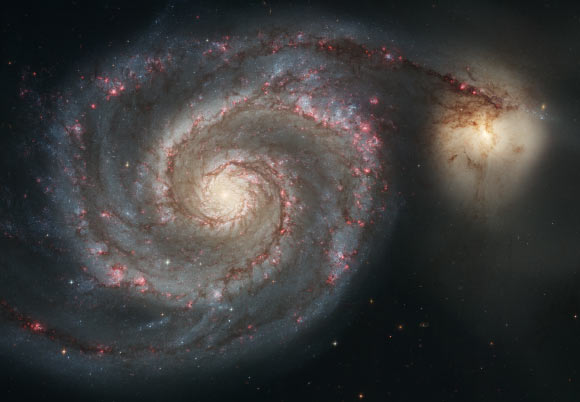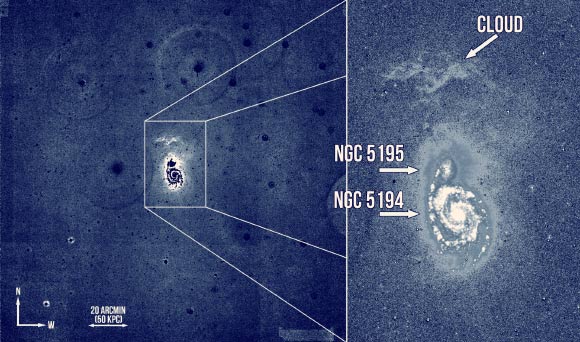A research team led by Case Western Reserve University astronomers has found a never-before seen cloud of ionized gas associated with the Whirlpool Galaxy, also known as Messier 51a, M51a and NGC 5194, an interacting grand-design spiral galaxy located in the constellation Canes Venatici, about 26 million light-years away. The discovery, reported in the Astrophysical Journal Letters (arXiv.org preprint), provides astronomers with an unexpected ‘front row seat’ to view the behavior of a supermassive black hole and associated galaxy as it consumes and ‘recycles’ hydrogen gas.

This Hubble image shows the Whirlpool Galaxy (NGC 5194) and its companion galaxy, NGC 5195. Image credit: NASA / ESA / S. Beckwith, STScI / Hubble Heritage Team / STScI / AURA.
“I literally looked at the image and said, ‘What in the world is that?’ What it was turned out to be a massive cloud of ionized hydrogen gas spewed from a nearby galaxy and then essentially ‘cooked’ by radiation from the galaxy’s central black hole,” said Professor Chris Mihos, an astronomer at the Case Western Reserve University.
“We know of a few clouds like this in distant galaxies, but not in one so close to us. This gives astronomers a great opportunity to study up close how gas is ejected from galaxies and how black holes can influence large regions of space around those galaxies.”
Named the M51 Cloud, the object spans around 81,500 x 24,460 light-years in size and is located 104,370 light-years north of Whirlpool Galaxy’s center.
It was discovered through deep wide-field imaging using the Burrell Schmidt Telescope at Kitt Peak National Observatory.
“We needed to know whether that cloud was moving at ‘Milky Way speed’ or ‘M-51 speed’,” Professor Mihos said.
“Once we had taken the spectrum of the cloud, they were able to tell how fast it was moving away from us, and we immediately knew it was part of M51, not something in our own back yard.”
“The discovery’s role in more clearly understanding how galaxies eject and ‘recycle’ their gas and stars will be determined in the coming years as more researchers dig into information that had been there all along — even if unseen until now,” he added.
“We need a lot more data to tell this tale fully, for sure, and this is one of the most well-studied galaxies out there.”
“So, we have a chance to better understand what is happening in the Whirlpool, which informs and affects how we understand everything else about how it has evolved over time.”
_____
Aaron E. Watkins et al. 2018. Discovery of a Vast Ionized Gas Cloud in the M51 System. ApJL 858, L16; doi: 10.3847/2041-8213/aabba1








